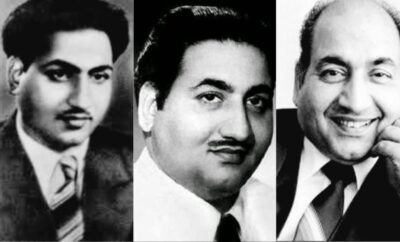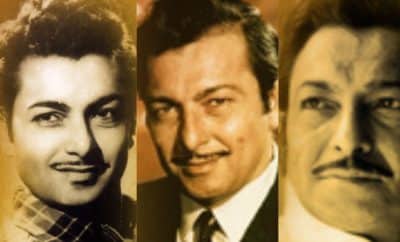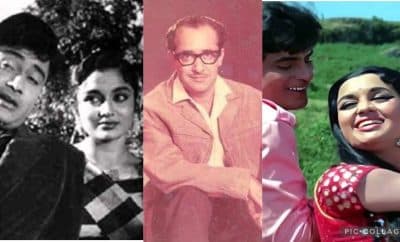Collections
Shamshad Begum and her Gentle Ditties
She was one of the first voice-lending playback singers of Hindi cinema. She rendered over 6,000 songs in Hindi and a few other Indian languages, spanning across several moods. She was a favourite singer of all the renowned composers during the 1940s, and remained so even in the later years for some composers like Naushad and O.P. Nayyar. In the first decade of her career, she lent her voice to almost all the leading actresses (other than the ones who were singers themselves). We simply cannot imagine the poised challenge in “Teri mehfil mein kismat aazma kar hum bhi dekhenge” (Mughal – E – Azam, 1960) or exuberant playfulness in “Leke pehla pehla pyaar” (C.I.D., 1956) or the bubbly excitement in “O gaadiwale gaadi Dheere haank re” (Mother India, 1957) in any other voice!
Yes, you are right! It’s Shamshad Begum, the playback singer with a sharp, crystal-clear and powerful voice with an astounding range! It is said that her voice was so strong that she had to stand a few feet away from the microphone while recording.
Born on 14th April 1919 in Lahore (now in Pakistan) in a conservative Punjabi Muslim family with little musical background, she had a flair for singing right from the tender years. Her talent was first spotted by the principal of her school, who made her the head singer of the classroom prayer. She also started singing folk songs at religious and family functions at the age of ten. However, her parents never encouraged her singing ambition. When she was twelve, her uncle secretly took her to Xenophone Music Company for an audition with the maestro Ghulam Haider. Impressed with her singing acumen, Ghulam Haider awarded her a contract for twelve songs. At the insistence of her paternal uncle, her father agreed to let her sing on the condition that she would record in burka and would not allow herself to be photographed. Her popularity grew in elite circles in the early 1930s through the Xenophone records. Though she had no formal musical training, the renowned Sarangi player Hussain Bakshwale Sahab and Ghulam Haider improved her singing skills in the 1930s.
She became more popular when she started singing on All India Radio (AIR) in Pesahwar and Lahore from 1937. In the meantime, a teen aged Shamshad Begum married Ganpat Lal Batto, a Hindu law student in her neighbourhood, in 1934 despite strong opposition from both the families on account of the religious differences.
Her songs being frequently broadcast on AIR paved her way to the films. Producer Dilsukh Pancholi selected her for one of his films after a screen test. However, her furious father strongly opposed this and warned her that she would not be allowed to sing, let alone acting in the films. Promising her father that she would never appear before camera, she stuck to singing.
Though she made her playback debut in the Punjabi movie Yamla Jatt (1940), Ghulam Haider also launched her in some of his earlier films like Khazanchi (1941) and Khandan (1942). Shamshad Begum lent her voice to Nargis in her first lead role in Taqdeer (1943) under the music direction of Rafiq Ghaznavi. She soon started singing for almost all the then leading composers.
In the mid-1940s, a few more composers like Naushad, C. Ramchandra and S.D Burman rose to fame. Shamshad Begum extensively sang for all of them, particularly Naushad and C. Ramchandra. While Naushad has acknowledged her contribution in his success, C. Ramchandra also expressed a regret that he did not use her voice much later, though she many times came to his rescue in crisis in his initial years. By the end of the 1940s, she was an established playback singer. Though with the rise of the two Mangeshkar sisters, most of the earlier actress-singers and playback singers were swept away, Shamshad Begum successfully held her ground and remained a leading playback singer till the mid-1950s. Post 1950, she appeared mainly in the music of Naushad and O.P. Nayyar.
While she was at the peak of her career, her husband died in an accident in 1955, after which she became recluse and stopped singing for some time. She resumed singing with Mother India (1957), when Mehboob Khan approached her. Having made a successful comeback with this, she sang many hit songs till 1965, after which she reduced her singing assignments and completely stopped singing in the early 1970s. As an acknowledgement of her contribution to Hindi film music, she was conferred with the O.P. Nayyar award and Padma Bhushan, both in 2009.
She breathed her last on 23rd April, 2013 after a prolonged illness at the age of 94 in Mumbai.
Let us glance through some of the gentle ditties that this profound singer always remembered for her mighty voice has proficiently rendered.
1. Na Bol Pee Pee More Angna (Dulari – 1949)
A sweet song composed by Naushad and penned by Shakeel Badayuni, filmed on Geeta Bali.
2. Mere Piya Gaye Rangoon (Patanga – 1949)
This evergreen duet sung by C. Ramchandra and Shamshad Begum remains popular even today. The lyrics are penned by Rajinder Krishan. The song is filmed on Shyam and Nigar Sultana.
3. Saiyan Dil Mein Aana Re (Bahar – 1951)
A lovely song expressing the wool-gathering of an adolescent girl (Vaijayanti Mala) in love, composed by S.D. Burman and written by Rajinder Krishan. This was Vaijayanti Mala’s first Hindi film.
4. Main Rani Hoon Raja Ki (Aan – 1952)
Another sweet song composed by Naushad and written by Shakeel Badayuni.
5. Kabhi Aar Kabhi Paar (Aar Paar – 1954)
A beautiful O.P. Nayyar composition, with lyrics by Majrooh Sultanpuri. The delicacy with which Shamshad Begum has sung the words “teer-e-nazar” every time consistently is mind blowing!
6. Boojh Mera Kya Naav Re (C.I.D. – 1956)
Another lovely composition by O.P. Nayyar, again penned by Majrooh Sultanpuri, sung very adorably by Shamshad Begum.
7. Meri Neendon Mein Tum (Naya Andaz – 1956)
A romantic duet sung by Shamshad Begum and Kishore Kumar under O.P. Nayyar’s baton again, filmed on Meena Kumari and Kishore Kumar himself. The lyrics are written by Jan Nisar Akhtar.
The film also has a pleasant solo by Shamshad Begum, filmed on Meena Kumari.
Which one is your favourite? And do you know any other such gentle ditties by her?




Virender Gupta
April 14, 2024 at 9:11 am
Beautiful selection and writeup
Mangesh Deshpande
April 14, 2025 at 9:16 am
Really beautiful collection and writeup